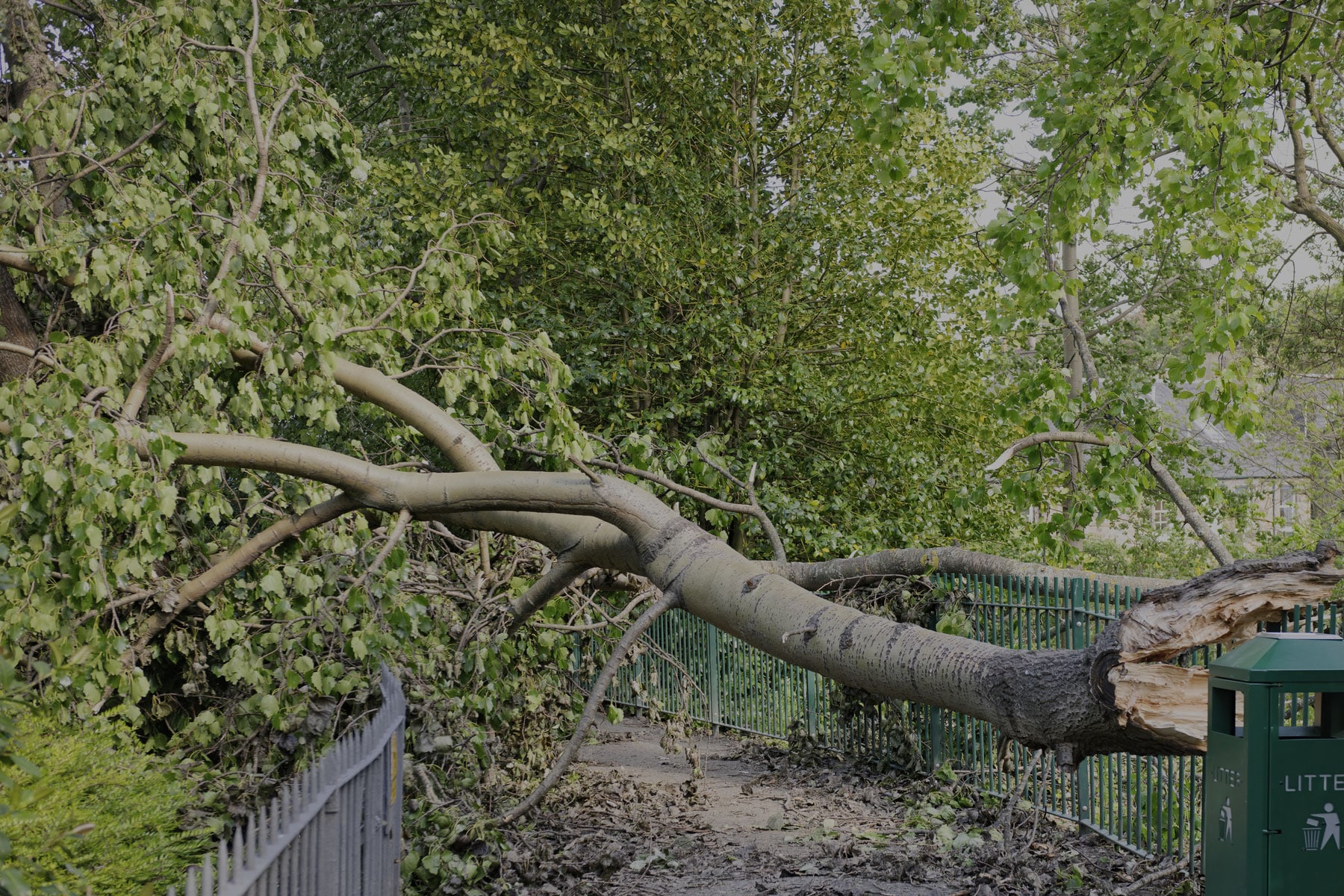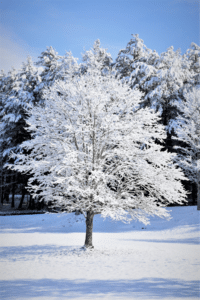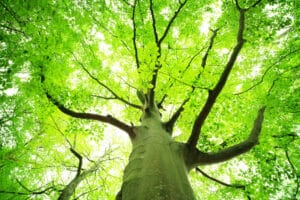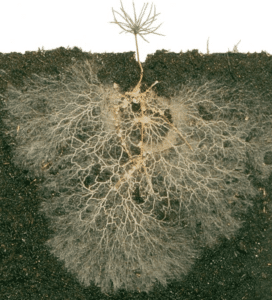This is a big subject that takes in many different factors which contribute to storm damage. So lets talk about storm damage. It creates dramatic headlines, distress to those directly affected either through damage of property or loss of life and requires drastic action in dealing with the aftermath. In this blog we will look at many factors, wind, soil, type of trees, location.

So…. Some trees fall and others stay standing, why?
Windthrow storm damage
It boils down to windthrow. If you think about leverage for a moment. The longer the lever the greater the leverage. The same applies to trees. The taller the tree especially when it is above the height of your roof the greater the leverage on the tree and the root plate. The taller the tree the more susceptible they are to wind throw. Also, to add to the equation is the sail effect.
If a tree has a congested busy crown the sail effect will increase this is of course even more of a problem for ever green trees. Ever green trees catch the wind a lot more than deciduous trees and can and do sway violently in high gusty winds. Much of this will be influenced by the time of year and what the seasons are bringing, which varies.
storm damage case study
I recall one year where a lime tree fell the circumstances were somewhat unusual. So, for starters earlier in the year I had noticed the tree had a previous rip out and this had left a huge scar on one side, also there was a crack line down the side of the tree. Six months earlier I had said to the customer that in the not to distant future it would need dealing with.
That autumn was unusually dry and then we had some late rains in December Lime trees are known for a high water up take in such circumstances. That January we had storms one of which was very gusty and the torsion on the tree was extremely bad as I watched the crack open and close. Later that day the top two thirds of the tree fell. Narrowly missing the neighbours Mac Laren P50, which would have been sad if it had gone for a burton. The storm damage in this case was three ridge tiles and a few slates on a garage roof.
So, in the case of the lime tree it had previous damage, a significant crack line down the side of the trunk, a top-heavy crown due to the massive up take of water and violently gusty winds equals majority of the tree crashing to the ground. The actual damage was three ridge tiles and a number of slates, considering its location the potential damage was much greater and in this case the customer was very fortunate. So, in this case it was a combination of wind and rain, however snow and ice can also have a great effect too.
In built up areas the tree’s root plate can be damaged or inhibited by close development. The radius of a tree’s root plate can be between 1-2.5 times the radius of the crown of the tree. I have seen several situations where the roots have been cut, the root plate therefore destabilised and a terrific number of pathogens in the soil rapidly killing off the tree.
Fungi
Now before I say this, fungi is our friend, without it nothing would decompose and the world would be no more, literally. However, it also can shorten or end the life of a tree. Normally the feed off deadwood or decaying wood and at times feeds directly off the tree’s sugars, the tree in turn dries it self out and goes from being supple to being brittle. This obviously leaves it susceptible to the tree’s branches snapping out sometimes without warning or notice.
The structure of the tree is another consideration it is not like blocks of wood of equal strength and suppleness. For example, a co dominant trunk has two rounds not one. Picture a figure of 8 squashed that’s co dominant as opposed to a normal trunk is a single circle. Where the squashed 8 meets is always a weak point. There are several types of co dominance and some are stronger than others, this is where you need a professional arborist to visually tell the difference and evaluate to risk.
Other storm damage problems
Other problems can come from trees in shallow soil, poor soil, or frequent anaerobic conditions.
So, does this all really matter, well, yes. Bear in mind in Peter Wohlleben’s book “The hidden life of trees” a mature oak in storm conditions can be taking the stress of 200 tonnes on the main trunk, forces of this magnitude are hard to imagine.
(https://www.amazon.co.uk/Hidden-Life-Trees-International-Communicate/dp/0008218439/ref=sr_1_1?crid=LZCQCAR37JBH&keywords=the+hidden+life+of+trees&qid=1647888747&s=books&sprefix=the+hidden%2Cstripbooks%2C228&sr=1-1
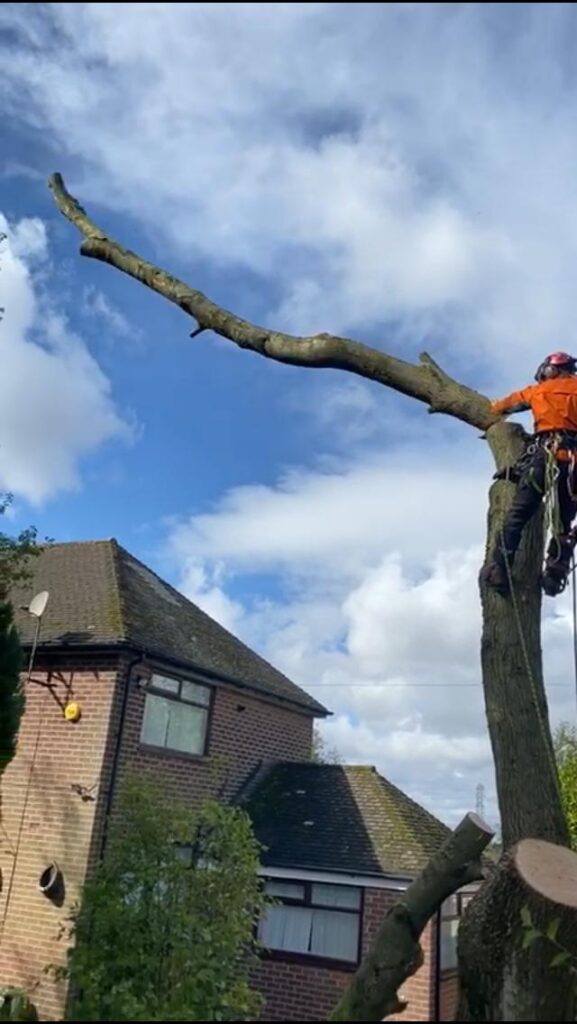
Are there any particular species of trees more at risk of storm damage?
In built up areas storm damage is obviously most prevalent. In my own experience it is a case of wrong plant wrong place. So, picture the scene small terrace house with a smaller garden with a mature tree it’s not hard to figure out this is going to cause a problem for the house holder and the neighbours.
According to Chris Mattheck some of the weakest wood is Spruce, Willow, Pine, Fir, Poplar. (https://www.trees.org.uk/Book-Shop/Products/The-Body-Language-of-Trees-Encyclopedia-of-Visual
All trees should be monitored for any weakness in relation to storm damage but most especially these species. Trees that are more at risk are those in towns and cities. So, a typical scenario is where someone is extending their home or put in a new drive and they cause root damage in the process. Or at the edge of urban development and where once trees were grown together, they are left as stand alone.
This doesn’t work well for the long-term stability of the tree. We now know that part of the trees stability and nutrition sharing is through an intricate network of roots that inter lace for stability and fuse together in sharing water and food.
Root Plate
What we do with the tree root plate has a huge impact on how the tree will or will not grow. Any development that involves drainage, cutting roots, changing the profile of the soil like building it up against the trunk or soil compaction can all shorten the life of the tree.
Physical damage is another factor. Minor damage caused by squirrels is normally not a major problem. In urban areas I’ve found physical damage from a lorry backing into the tree near the base and ripping off the bark. Why is this a problem? Simply put, a trees immunity is its bark. Trees do not have an immunity like you and I so if there is a wound to prevent infection it must heal over if it doesn’t more often than not a fungus moves in and starts feeding off the tree sugars and so the decline begins.
Mattheck also brings up the subject of “The critical slenderness ratio” or the height to density ratio. If your tree has a wide trunk and is relatively low the chances of falling are low. If on the other hand the trunk is thin and the height tall like a pine where there is also a concentration of foliage and the top half of the tree, then the likely hood of the tree falling is higher. Just to add into the mix Pines are shallow rooted.
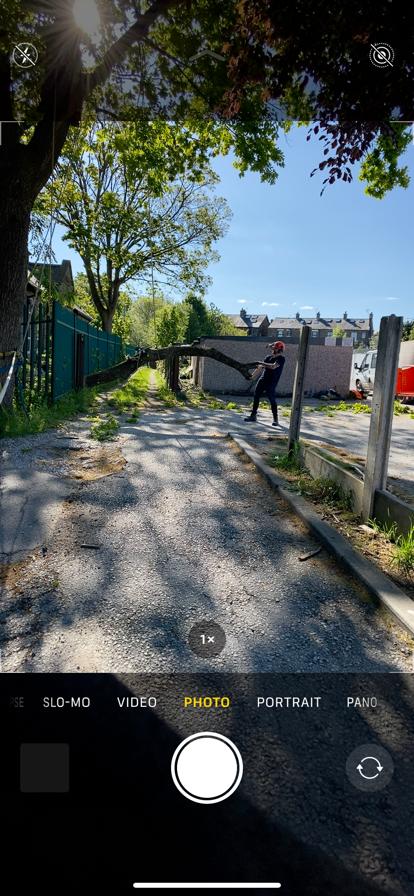
How much rain is too much rain before the roots die off?
To answer this question, we have to take a look at soil science. If your soil is light or sandy it is not an issue at all the rainwater will drain away just fine, the greater concern, in this case, is soil erosion. If your soil is heavy clay soil or if the water table is unusually high then root rot will be a serious problem in such an instance. As much as 90% of the tree’s roots are in two feet of soil.
Different trees produce different root systems how does the soil influence that?
So if the soil retains a high level of water, root growth will be inhibited. Roots require oxygen in order to grow if the oxygen is not present then no growth, therefore the likelihood of the tree falling is greatly increased.
Root spread
de Vos: “Deciduous trees tend to have a greater lateral root spread compared to conifers which tend to have a more fibrous and compact root system. Soil type and its appropriateness for the species of tree in question is paramount to success. … Sandy soil has good aeration but poor nutrient holding capacity while clay soil has poor aeration and excellent nutrient holding capacity.
The best of both worlds is a clay loam with a bit of both. The better the relationship between soil and species the better the root development as long as there are no limiting urban factors like walls and roads, buildings and pipelines. A good soil will promote deeper roots as it will have oxygen to a lower level as the water leaches out.
Is there any way of telling if my tree is likely to fall, or drop any branches?
Lets start with the obvious. Does the tree lean at an angle or not? If it does has this changed over the years? I climbed a tree that was on an extreme lean which had very little holding wood. The bounce and movement was really bad trees of this nature should not be ignored.
Are there cracks in the trunk? I’ve witnessed a number of trees in this condition when tested in gusty winds fail and cause a fair amount of destruction. If you see this call in a professional arborist and have the tree surveyed.
Is the crown full of foilage and vigourous juvenile growth from one season to the next? What I suggest to my customers on this issue is take a photo, put a date in your diary for the same time next year, take another photo and compare. When I say compare I mean a good 20 minutes of studying the images over a cup of tea and if need be a sticky bun. If they are the same, ok, if thriving terrific, if declined bad news, call in a professional. Either way it is a more objective way of assessing the health of the tree and the direction of travel.
Roots are harder to assess. Again we look for noticeable cracks or physical damage at the base of the tree, Is the bark cracked or broken is there discoloration of the wood.
Are there mushrooms at the base of the tree, this is not automatically bad as not all mushrooms are bad for the tree. Ones to look out for are:
Long list of fungi
Kretzschmaria Deusta,
Fistulina Hepatica,
Phaeolus Schweinitzii,
Sparaddis Crispa,
Armillaria Mellea,
Armillaria Ostoyae,
Pholiota Squarrosa,
Collybia Fusipes,
Ganoderma Applanatu
Meripilus Giganteus,
Grifola Frondosa,
Ganoderma Australe,
Hypholoma Fasciculare,
Ganoderma Pfeifferi,
Perennipria Fraxinea,
Ganoderma Resinaceum,
Inoonotus Dryadeus,
Heterobasidion Annosum,
Hypholoma Fasciculare,
Coprinellus micaceus,
Laetiporus sulphureus,
Daedalea quercina,
Fomes Fomentarius,
Phellinus Robustus,
Piptoporus Betulinus
Phellinus Igniarius,
Fomitopsis Pinicola,
Phellinus Tuberculosus,
Daedalea quercina,
Phellinus Pini,
Polyporus Squamosus,
Inonotus Hispidus,
Pholiota Aurivella,
Inonotus Cuticularis,
Daedaleopsis Confragosa,
Inonotus Obliquus,
Pleurotus Ostreatus,
Pholiota Populnea,
Pholiota Aurivella,
Daedaleopsis Confragosa,
Daedaleopsis Tricolor,
Bjerkandera Adusta,
Trametes Versicolor,
Biscogniauxia Nummaularia,
Trametes Hirsuta,
Hypxylon Cohaerens,
Trametes Gibbosa,
Schizophyllum commune,
Stereum Hirsutum,
Biscogniauxia Nummaularia,
Hypxylon Cohaerens,
Astreosporium Asterospermum,
Gloeophtllum Sepiarium,
Gloeophyllum Abittinum,
Gloeophyllum Trabeum,
Lentinus Lepideus,
Poria/Antrodia,
Pazillus Panuoides.
The list above is not comprehensive or complete but at least highlight the most common fungi that are a problem to trees and their health
If you see any of the above fungi call in a professional to assess your tree as soon as possible to conduct a visual tree assessment at the very least and preferably a full tree survey.
Having thought this through I’m sure I will probably follow up with another related blog in time. I hope you find this helpful and allows you to make informed choices regarding your trees.
This other page gives more information about the damage storms can cause.
Arboricultural Association – Most fallen trees can stay where they are – Storm update
And some more information and tree care:
Crown reduction for your trees – Roots and Shoots Manchester

